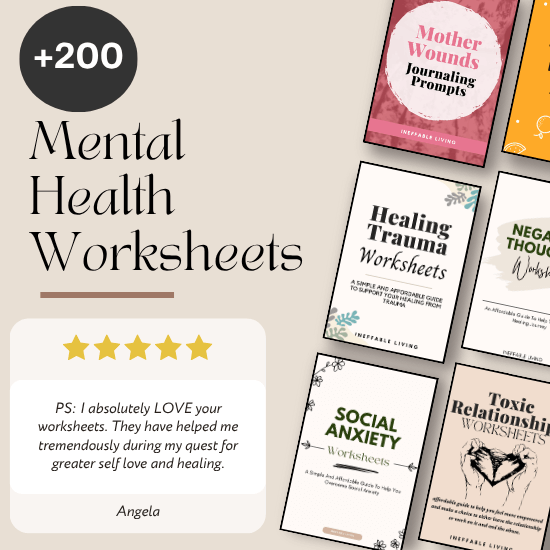Mental health worksheets might seem simple on the surface—just questions on paper.
But beneath that simplicity lies a powerful psychological tool backed by science.
These structured prompts can actually help reshape thought patterns, regulate emotions, and strengthen inner resilience.
Here’s why worksheets work—and how they support real healing.
What Are Mental Health Worksheets and How Do They Work?
Mental health worksheets are printable or digital exercises based on proven psychological techniques like:
- Cognitive Behavioral Therapy (CBT)
- Mindfulness and grounding
- Self-compassion
- Trauma-informed care
- Emotion regulation and boundary setting
They typically include prompts, reflection questions, tracking tools, emotional check-ins, and practical strategies to help you process what you’re feeling and why.
These worksheets help you slow down, reflect, and take control of your mental space by guiding you through steps like:
- Identifying what you feel instead of avoiding or suppressing emotions
- Challenging negative thought patterns that drain your energy or self-worth
- Tracking emotional triggers and recurring stressors
- Creating actionable self-care or boundary-setting plans
- Building emotional regulation skills so you can respond (not react)
You can use them independently, with a therapist, or as part of a regular self-check-in practice.
The Surprising Science Behind Using Mental Health Worksheets for Healing
1. They Activate the “Thinking Brain” Over the “Feeling Brain”
When you’re overwhelmed, your emotional brain (amygdala) takes over. Writing engages the prefrontal cortex, helping you think more clearly. Worksheets ground you in logic and reflection, reducing emotional reactivity.
2. They Externalize Internal Chaos
Thoughts and emotions can feel huge and tangled in your mind. Writing them down creates distance, clarity, and containment. You can see the problem, not just feel it.
3. They Create a Safe, Structured Space for Emotional Processing
Unlike open-ended journaling, worksheets offer guided prompts that help you gently access difficult emotions without getting lost in them. The structure helps regulate the intensity.
Related: Need Better Therapy Tools? These Worksheets Empower Your Clinical Work
4. They Support Cognitive Behavioral Therapy (CBT) Techniques
Many worksheets mirror core CBT practices—identifying thought distortions, challenging negative beliefs, and tracking behavioral patterns. These techniques are research-proven to reduce anxiety, depression, and stress.
5. They Strengthen Metacognition (Thinking About Your Thinking)
Answering prompts like “What triggered this feeling?” or “What are three alternative thoughts?” helps you step outside your mental autopilot. This builds self-awareness and emotional intelligence.
6. They Tap Into Neuroplasticity
Writing repeated affirmations, tracking wins, or challenging negative thoughts helps rewire neural pathways over time. The more you practice, the more your brain learns new emotional habits.
7. They Provide Tangible Evidence of Progress
Seeing your own handwriting evolve over time—how your answers change, soften, or deepen—is motivating. Worksheets create a visible trail of healing and growth.
8. They Improve Emotional Regulation
Studies show that expressive writing reduces the intensity of distressing emotions. Worksheets take this a step further by combining expression with reflection and action.
9. They Encourage Follow-Through With Healing Goals
Unlike vague intentions, a worksheet asks you to do something: identify triggers, write an action plan, commit to a coping skill. This increases follow-through and accountability.
Related: Carrying Old Wounds? These Worksheets Help You Start Healing Your Trauma
10. They Offer a Non-Judgmental Companion
A worksheet doesn’t interrupt, judge, or react. It creates a quiet, consistent space for self-inquiry—something many people rarely receive in their daily lives.
11. They Bridge the Gap Between Therapy Sessions
Using worksheets between therapy sessions helps reinforce insights, track patterns, and stay connected to healing work—especially when motivation is low.
12. They’re Accessible Tools for Self-Guided Healing
You don’t need a therapist in the room to benefit. Worksheets empower people to begin their own mental health work in a gentle, guided way.
13. They Normalize and De-Stigmatize Mental Health Work
Filling out a worksheet can feel approachable—less intimidating than opening up in conversation. It offers an entry point into deeper healing, especially for those who struggle with emotional expression.
Related: Feel Like You Can’t Move Forward? These Worksheets Help You Get Unstuck

Conclusion
Mental health worksheets are more than paper exercises—they’re powerful brain tools, therapeutic companions, and self-guided healing rituals. In a world that moves fast and asks for constant performance, these quiet pages offer a rare, essential space: one where you can slow down, listen inward, and begin to heal—one prompt at a time.